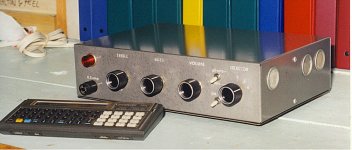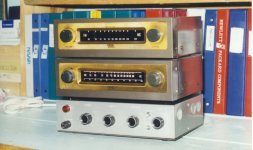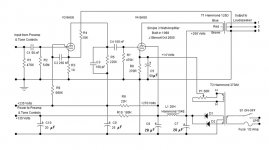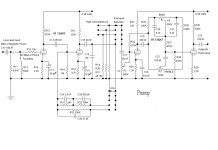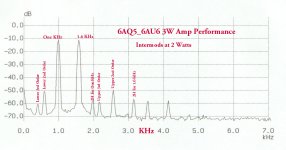This one combines Amp, Preamp & PS all inside a Hammond 8x12x3 Chassis. Built in 1968 it still runs most everyday with the EICO AM & FM Tuners in the workshop.
Does it sound musical? Not at all. It is dead quiet, unless driven by a program source. The way I intended it to be.
But not that much 'Out of the Box'. This one is rather straight forward.🙂
Does it sound musical? Not at all. It is dead quiet, unless driven by a program source. The way I intended it to be.
But not that much 'Out of the Box'. This one is rather straight forward.🙂
Attachments
Schematics & Performance Data
I managed to build the entire amp, tone controls & preamp into a Hammond 8 x 12 x 3 chassis. Most of the major components are on a 3 x12 sub-chassis inside. That includes the power supply, power amp, preamp & tone circuits. I assembled the sub-chassis on the bench. The controls, input & output connections are mounted on the front & rear panels of the chassis. These were all wired together at the final assembly stage.
Since there is some heat to be dissipated, I used a set of four one inch diameter ventilation hole plugs mounted on the ends of the chassis. There are several ½ inch holes in the bottom plate to allow cooling air in.
The amplifier is by no means optimized & if I were to build another today I would make a few changes. The most important of these changes would be to use one of the new Hammond output transformers (OPT) specifically designed for single ended (SE) applications. At the time I had the Hammond 125D in my junk box, so it was easy to incorporate into this amp. But one of the new SE OPT’s would yield quite an improvement in the low frequency performance.
There are four inputs, three of these to be used with receivers or other high level sources such as a CD player (I do). Full output is possible with only 70 mv on those jacks, so any source with a nominal one volt output works well. The low level input is corrected for something like the GE Variable Reluctance phono cartridges that were common at the time. Since I had a crystal mike I added the ability to use that as well. A miniature SPST switch on the front panel allows change of the preamp input loading. Another front panel miniature SPST switch is in the heater circuit of the 12AX7 V1. This can be shut off, thus extending the tubes life while not in use.
Most of the preamp & tone control circuitry is a direct lift from some of the circuits used by Eico. You may recognize the tone circuit as the Baxandall. The only connection the circuit has to the chassis is at the phono connector. There are two switched AC outlets on the rear panel to supply my tuners.
As shown there is 17 db NFB around the power amp. The resulting Damping Factor is 6.7 at one Khz. Power output is a little more than three watts maximum, enough for many applications. The power supply is very simple. The Hammond 270AX is meant to be used with a 6X4 rectifier, but I used some silicon rectifiers in order to somewhat limit the heat developed inside the chassis. I connected the heater supply (HH) to the 6AQ5 cathode so that it is lifted 14 volts above ground. That helps to minimize hum from the preamp.
All of the Total Harmonic Distortion (THD) & Intermodulation Distortion (IMD) measurements were taken with one of the Pico Technologies Virtual Instruments.
And the amp sounds OK for the application I had in mind.🙂
I managed to build the entire amp, tone controls & preamp into a Hammond 8 x 12 x 3 chassis. Most of the major components are on a 3 x12 sub-chassis inside. That includes the power supply, power amp, preamp & tone circuits. I assembled the sub-chassis on the bench. The controls, input & output connections are mounted on the front & rear panels of the chassis. These were all wired together at the final assembly stage.
Since there is some heat to be dissipated, I used a set of four one inch diameter ventilation hole plugs mounted on the ends of the chassis. There are several ½ inch holes in the bottom plate to allow cooling air in.
The amplifier is by no means optimized & if I were to build another today I would make a few changes. The most important of these changes would be to use one of the new Hammond output transformers (OPT) specifically designed for single ended (SE) applications. At the time I had the Hammond 125D in my junk box, so it was easy to incorporate into this amp. But one of the new SE OPT’s would yield quite an improvement in the low frequency performance.
There are four inputs, three of these to be used with receivers or other high level sources such as a CD player (I do). Full output is possible with only 70 mv on those jacks, so any source with a nominal one volt output works well. The low level input is corrected for something like the GE Variable Reluctance phono cartridges that were common at the time. Since I had a crystal mike I added the ability to use that as well. A miniature SPST switch on the front panel allows change of the preamp input loading. Another front panel miniature SPST switch is in the heater circuit of the 12AX7 V1. This can be shut off, thus extending the tubes life while not in use.
Most of the preamp & tone control circuitry is a direct lift from some of the circuits used by Eico. You may recognize the tone circuit as the Baxandall. The only connection the circuit has to the chassis is at the phono connector. There are two switched AC outlets on the rear panel to supply my tuners.
As shown there is 17 db NFB around the power amp. The resulting Damping Factor is 6.7 at one Khz. Power output is a little more than three watts maximum, enough for many applications. The power supply is very simple. The Hammond 270AX is meant to be used with a 6X4 rectifier, but I used some silicon rectifiers in order to somewhat limit the heat developed inside the chassis. I connected the heater supply (HH) to the 6AQ5 cathode so that it is lifted 14 volts above ground. That helps to minimize hum from the preamp.
All of the Total Harmonic Distortion (THD) & Intermodulation Distortion (IMD) measurements were taken with one of the Pico Technologies Virtual Instruments.
And the amp sounds OK for the application I had in mind.🙂
Attachments
- Status
- Not open for further replies.

